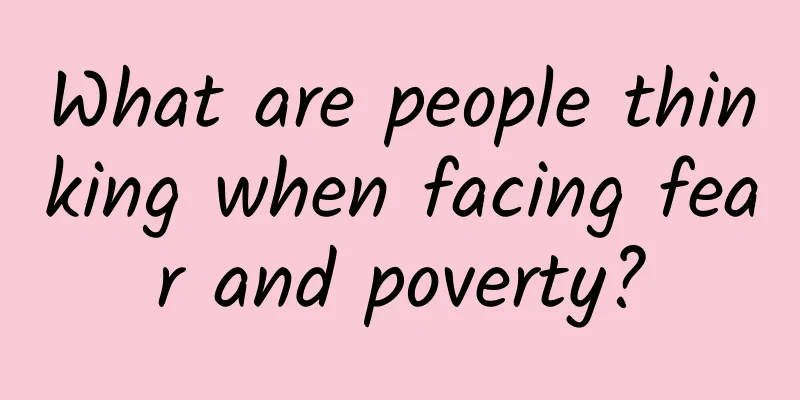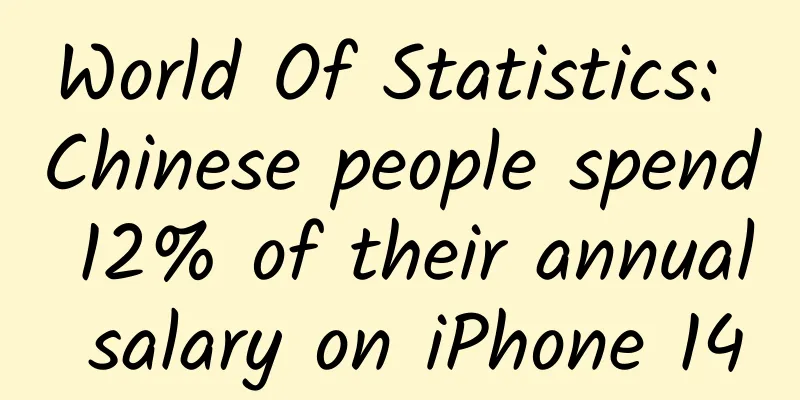What are people thinking when facing fear and poverty?

|
Authors: Tao Rui, Liu Huan, Wei Zihan, Li Minghui (Institute of Psychology, Chinese Academy of Sciences) The article comes from the Science Academy official account (ID: kexuedayuan) Author's Note We usually think that people's subjective feelings are linearly related to changes in the objective environment. Freedom from fear and freedom from poverty are two basic freedoms, and they are related to changes in the objective environment. However, the two counterintuitive effects reviewed in this article suggest that there are complex psychological mechanisms behind people's response to environmental changes and pursuit of these two freedoms: the correspondence between the objective environment and subjective feelings may be nonlinear. The first counterintuitive effect is the “psychological eye of the typhoon” effect, that is, the closer you are to high risk, the calmer you become psychologically. The second counterintuitive effect is the "urban dislocation" effect, that is, although the objective living standards of urban residents are between those of urban and rural areas, their subjective level of residential attachment is not between (lower than) that of urban and rural areas. Freedom from fear and freedom from want are two of the “fundamental human freedoms” proposed by Franklin Roosevelt (1941) (Figure 1). The United Nations Millennium Declaration (United Nations, 2009) also clearly states that the development goal of the international community is to help humans have freedom from fear and freedom from want. So how did these two become part of the “four fundamental freedoms”? And what motivates us to fight so hard for freedom from fear and freedom from want? Figure 1 The left picture shows the relief of the Four Freedoms, located in the Franklin Delano Roosevelt Memorial in Washington, DC; the right picture shows Franklin Delano Roosevelt, the 32nd President of the United States. Image from Wikipedia: https://en.wikipedia.org/wiki/Four_Freedoms Environmental changes → psychological changes If you think about it carefully, its origin is closely related to the changing environment. The objective environment we live in is constantly changing, either getting worse or better. On the one hand, natural disasters (such as earthquakes, typhoons, floods, and tsunamis) destroy our objective environment, that is, heaven sends fear to human beings, so we seek freedom from fear; On the other hand, in order to avoid poverty, humans artificially transform nature to improve the objective environment. The process of industrialization and urbanization has always been a way for humans to avoid poverty and move towards prosperity (Figure 2). In the face of environmental changes, people must mobilize their body resources and make adaptive judgments and responses in order to survive. This is the so-called "the mind is born from the environment" and "the mind changes with the environment." Specifically, in the context of "natural disasters" and "transforming nature", it means: freedom from fear and poverty. Figure 2 Various environmental changes that humans may encounter: tsunamis and earthquakes are related to freedom from fear; urbanization and industrialization are related to freedom from poverty. All images are from Baidu. In the face of environmental challenges and changes, humans have evolved a number of coping and adaptation mechanisms. When we are in danger, we feel afraid; when we are in a beautiful place, we feel happy. Common sense holds that subjective feelings should change linearly with changes in the objective environment, that is, the more dangerous the environment (objective), the more afraid people should be (subjective); the better the environment (objective), the happier people should be (subjective). However, after collecting data from tens of thousands of subjects over several years, Li Shu's research team at the Institute of Psychology, Chinese Academy of Sciences, discovered two counterintuitive effects, revealing that the relationship between subjective feelings and the objective environment is not necessarily linear. Counterintuitive effect 1: “Psychological eye of the typhoon” Fear is the human instinctive response to various environmental dangers (Soyk, 2011). The academic community often uses the "ripple effect" (Slovic, 1987) to describe our psychological response to severe natural disasters such as earthquakes, typhoons, and floods - just like ripples spreading outward, the impact of unfortunate encounters will gradually weaken with time and distance. However, in real life, the relationship between objective danger and subjective fear is not like this. In May 2008, a magnitude 8.0 earthquake struck Wenchuan. Li Shu et al. conducted a large-scale survey of residents in non-disaster areas (542 people in Beijing, Fujian, and Hunan) and disaster areas (1,720 people in Sichuan and Gansu). The survey surprisingly found that the closer the residents were to the epicenter, the calmer they were mentally. That is, as the severity of the disaster in their location increased (from non-disaster, slightly affected, moderately affected to severely affected), the residents estimated that the demand for doctors in the disaster area, the demand for psychological workers in the disaster area, the possibility of large-scale infectious diseases in the disaster area, and the number of earthquake avoidance measures needed to be taken all decreased (Figure 3; Li et al., 2009). Figure 3 Relationship between the degree of concern about safety and health issues after the earthquake and the level of damage to the residence Researcher Li Shu named this effect the "psychological typhoon eye" effect (Figure 4), that is, in the time dimension, the closer to the high-risk period, the calmer the mind; in the spatial dimension, the closer to the high-risk area, the calmer the mind. Figure 4 Typhoon eye: Because there are many typhoons in Fujian, the hometown of researcher Li Shu, Li Shu intentionally named this effect the "psychological typhoon eye" effect. Image from Baidu. (Editor's note: The circular area with a diameter of about 10 kilometers from the center of the typhoon is usually called the "typhoon eye" in meteorology. The air in it hardly rotates and the wind is relatively weak) Two variants Variation 1: The relationship version of the “psychological eye of the typhoon” effect: Four and 11 months after the Wenchuan earthquake, Li Shu and his colleagues conducted two follow-up studies on 4,178 residents in the disaster area (Sichuan and Gansu) and 1,038 residents in non-disaster areas (Beijing and Fujian). The two follow-up studies found that the "psychological eye of the typhoon" effect was still strong one year after the Wenchuan earthquake. At the same time, they also found a variation of the "psychological eye of the typhoon" effect - the relationship version of the "psychological eye of the typhoon" effect, that is, the closer the kinship with the victims who suffered property losses or the closer the kinship with the victims who suffered life injuries, the lower the residents' concerns about health and safety. Variation 2: The "Psychological Eye of the Typhoon" effect of involvement: Zheng Rui et al. (2015) conducted a household survey of residents living in a lead and zinc mining area in Fenghuang County, Xiangxi (217 villagers in the mining area). The study investigated the relationship between involvement and villagers' risk perception of mining. Among them, mining involvement is divided into four categories according to the different degrees of participation of local villagers in mining, from high to low: mine owners (villagers whose own land can produce ore), miners (villagers working in small mines), families of mine owners and miners, and villagers who are not involved in mining. According to common sense, the higher the degree of involvement in risk events, the higher their risk perception level should be. The survey results show that the risk awareness level gradually increases from mine owners to villagers who are not involved in mining, showing a clear "psychological eye of the typhoon" effect. The researchers call this the "psychological eye of the typhoon" effect of involvement, that is, the higher the degree of involvement in risk events, the lower the level of risk awareness (Figure 5). Figure 5 Average risk awareness level of villagers in Fenghuang County (higher scores represent higher risk awareness levels) Social Impact The "psychological eye of the typhoon" effect shows that subjective fear does not increase monotonically with the increase of objective danger. The discovery of the "psychological eye of the typhoon" effect has also attracted the attention of people from all walks of life: Noah Gray (2010), senior editor of Nature, believes that this result "is very important for policymakers, helping them to better formulate policies to respond to public health risks. Because it helps us better understand who is suffering from the disaster." The Washington Post conducted an in-depth report on the research on the “psychological eye of the typhoon” effect on environmental pollution risks titled “The Great Paradox of Human Perception of Environmental Risks”. The report believes that the discovery of the “psychological eye of the typhoon” effect fully demonstrates that simply presenting data and statistical results to the public cannot change their psychological cognition, and policymakers should communicate and interact more with the public when solving environmental problems (Harvey, 2015). Counterintuitive effect 2: “Urban dislocation” Since the reform and opening up, China has achieved tremendous economic growth and rapid urbanization. By the end of 2014, China's urbanization rate had reached 54.77%, exceeding the world average of 53% (National Bureau of Statistics, 2013). It seems reasonable to speculate that rapid economic growth and rapid urbanization will greatly improve residents' subjective well-being. However, researchers have found that in some developed countries, including the United States, Japan, the United Kingdom, France, Germany, Italy and the Netherlands, as per capita national income has continued to grow over the past decade, the mean of subjective well-being has remained almost unchanged (eg, Blanchflower & Oswald, 2004; Easterlin & Sawangfa, 2010). These results mean that subjective feelings do not change linearly with urbanization levels. Does this nonlinear relationship also exist in developing countries such as China? Wang et al. (2015) conducted a household survey of 3,716 residents in three types of regions (rural, urban, and urban) at different stages of urbanization from August to September 2007. The researchers investigated people’s subjective views on where they lived through direct and indirect measurements. The subjective indicator directly measured is the self-assessed social environment, that is, whether residents think that their place of residence has a harmonious and beautiful social environment. The subjective indicator indirectly measured (place attachment) is measured by a projective test (Li, 2016), that is, instead of directly asking residents about their attitude towards their place of residence, they are asked to make choices about matters that are of great importance to them, including asking them whether they are willing to choose a local as a life partner, whether they are willing to be reborn in the local area in the next life, whether they hope that their children will master the local dialect, and whether they have an emotional reaction to outsiders insulting locals (Wang et al., 2015). People with strong place attachment are more willing to choose a local as a partner, be a local in the next life, let their children master the local dialect, and show strong emotional reactions to outsiders' insulting words about locals. According to objective indicators (such as the mortality rate of children under 5 years old, the adult illiteracy rate, and the average monthly household income, etc.), the quality of life of residents shows a trend of rising from rural to urban areas as the urbanization level increases. Logically, the level of residential attachment of residents should also show a similar trend, that is, the residential attachment level of urban residents should fall between that of rural and urban residents. However, the research results show that the residential attachment level and self-assessed social environment scores of urban residents are lower than those of rural and urban residents (Figure 6; Wang et al., 2015). Figure 6 Mean “residence attachment” of rural, urban and urban residents (the larger the score, the more attached they are to the region) Given this “illogical” nature, Wang et al. (2015) called this V-shaped relationship the “town dislocation effect”, which describes the asynchronous changes between subjective perception and objective environment during urbanization. Although the “urban dislocation” effect is unexpected, it is still reasonable. A similar story is told in Aesop’s fables: The country mouse envied the city mouse for having delicious cakes and beer, so he moved to the city. However, after experiencing the huge difference between the city and the countryside, the country mouse thought that it would be better to return to the countryside to live a peaceful life instead of living in the city with tension and anxiety and enjoying delicious food. Just like the country mouse, people seem to have shown a similar “pastoral complex” in the face of the city (Wang et al., 2015). The two counterintuitive effects mentioned above suggest that the relationship between subjective feelings and changes in the objective environment may not be linear; there are complex psychological mechanisms behind people's response to environmental changes and their struggle for freedom from fear and poverty. The more humans regard freedom from fear and want as fundamental freedom, the more psychologists have the responsibility to identify the psychological defense mechanism of freedom from fear and the psychological adjustment mechanism of freedom from want. Since these mechanisms are still unknown, humans will continue to search for freedom. References: [1]Li, S., Rao, LL., Bai, [2]Li, S., Rao, LL., Bai, [3]Wang, F., Li, S., Bai, XW., Ren, XP., Rao, LL., Li, JZ., ... [4]Wei, ZH, Tao, R., Liu, H., & Li, S. (2017). 'Freedom From Fear and Want' and Our Psychological Response to Environmental Changes. Journal of Pacific Rim Psychology, 11. |
<<: What causes carotid artery plaques, and can it be improved through active treatment?
>>: Anger & Depression! Who is the culprit behind this?
Recommend
Common examinations for female infertility, keep these measures in mind!
Due to various reasons, female infertility has be...
Correcting dental and gum recession?
Generally speaking, orthodontic treatment will no...
My breasts are too big. Is there any way to reduce them quickly?
In life, many women are obese or have uneven bodi...
49 years old and no menstruation for two months
Although the normal arrival of menstruation is in...
What causes chest pain during six months of pregnancy?
Pregnancy is a very difficult process for women. ...
Where can I get relief from menstrual pain massage?
Many female friends will have some diseases durin...
How is melasma formed and how to solve it
You can imagine how great an impact chloasma will...
Will my belly swell during pregnancy?
Pregnancy is a very important period for women, b...
Female vulva herpes pictures
Many female friends do not actively seek treatmen...
Do I need to stay in bed during pregnancy when I have polyp bleeding?
Mothers during pregnancy are more rational and mo...
The car shakes. Is there carbon deposit somewhere? What does it mean when the car shakes when starting in first gear?
The car should be running smoothly. If it jerks o...
Are gestational age and gestational age the same?
I believe most pregnant women are familiar with g...
Is it necessary to add water to marinate beef? How to marinate beef with water?
We all know that beef is a common meat food. It i...
What are the techniques for exerting force during childbirth?
Pregnancy is a very common thing for women, but a...
How to tell whether the products sold in the market are golden apple snails? What is the difference between golden apple snails and field snails?
Snail meat is a must-have item in barbecue stalls...









